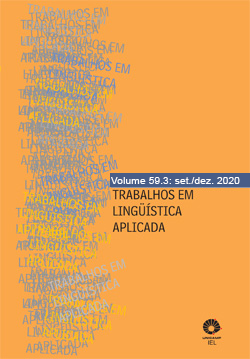Abstract
This article discusses the narrative practices of a Brazilian social movement whose members are the mothers and relatives of young people victimized by police raids into Rio de Janeiro’s favelas. By analysing the narratives produced by activists, we explore how grief is converted into political fight. As we look into how mothers intertwine their individual pain with political activism, we examine (i) how emotions and suffering are organized in their narratives; and (ii) what discursive strategies are used in the process. Data was generated during public demonstrations, and the analysis suggests that it is by turning the pain of a losing a child into political insurgence that mothers narratively organize their emotions. As stories get told, events surrounding the murders are recontextualized and experiences are collectivized. Mothers’ stories become narratives of resistance, which oppose institutional racism, but also narratives of re-existence (SOUZA, 2009), which recast the deaths of their children as an effect of a necropolitical logic of state organization.
References
BASTOS, L. C. (2005). Contando estórias em contextos espontâneos e institucionais – uma introdução ao estudo da narrativa. Calidoscópio. vol. 3, n. 2, p. 74-87.
BASTOS, L. C. & BIAR, L. (2015). Análise de narrativa e práticas de entendimento da vida social. DELTA – Documentação e Estudos em Linguística Teórica e Aplicada, vol. 31.
BAUMAN, R. (1986). Story, Performance, and Event: Contextual Studies of Oral Narrative. Cambridge: Cambridge University Press.
BRUNER, J. (1990). Atos de significação. Porto Alegre: Artes Médicas, 1997.
BUTLER. J. (2009) Quadros de Guerra: quando a vida é passível de luto? 1ª ed. Rio de Janeiro: Civilização Brasileira, 2015.
BUTLER. J. (2020). De quem são as vidas consideradas choráveis em nosso mundo público?. El País, 10jul. 2020. Disponível em: https://brasil.elpais.com/babelia/2020-07-10/judith-butler-de-quem-sao-as-vidas-consideradas-choraveis-em-nosso-mundo-publico.html Acesso em: 30 jul. 2020.
CERQUEIRA, D. et al. (2017). Atlas da violência - 2017. Rio de Janeiro: IPEA; São Paulo: FBSP. Disponível: http://www.ipea.gov.br/atlasviolencia/download/2/atlas-2017
DENZIN, N.; LINCOLN, Y. (2006). A disciplina e a prática da pesquisa qualitativa. In: Denzin, N.; Lincoln, Y. O planejamento da pesquisa qualitativa: teorias e abordagens. Porto Alegre: Artmed.
EWICK, P. SILBEY, S. (2003). Narrating Social Structure: Stories of Resistance to Legal Authority. AJS v. 108, n6 (may 2003), 1328-72, Chicago.
FACCHINI, R. SÍVORI, H. (2017). Dossiê Conservadorismo, Direitos, Moralidades e Violência: situando um conjunto de reflexões a partir da Antropologia. Cad. Pagu n.50, Campinas, Epub June 26.
FREIRE, J. 2011. Quando as emoções dão formas às reivindicações. In: Coelho, M. C. e Rezende, C. B. (orgs.) Cultura e Sentimentos - Ensaios em antropologia das emoções. Rio de Janeiro: FAPERJ, pp. 168-196.
GEORGAKOPOLOU, A. 2006. Thinking big with small stories in narrative and identity analysis. Narrative Inquiry, v.16, n.1, p.122-130.
GOMES, N. L. (2012). Alguns Termos E Conceitos Presentes No Debate Sobre Relações Raciais No Brasil: Uma Breve Discussão. Revista Educação e Sociedade. V.33, nº 120 – jul-set.
GONZALEZ, L. (1982) O Movimento Negro na última década. In Gonzalez, L. e Hasenbalg, C. Lugar de Negro. Rio de Janeiro: Marco Zero.
JASPER, J. (1997). The Art of Moral Protest: Culture, Biography, and Creativity in social Movements. Chicago: Chicago University Press.
KILOMBA, G. (2008). Memórias da Plantação: Episódios de Racismo cotidiano. Trad. Jess Oliveira. Rio de Janeiro: Cobogó, 2019.
LABOV, W. (1972). The transformation of experience in narrative syntax. In: Language in the inner city. Philadelphia: University of Pennsylvania Press.
LINDE, C. (1993). Life Stories: the creation of conference. NY: Oxford University Press.
LODER, L.L. (2008). O modelo Jefferson de transcrição: convenções e debates. In: L.L. Loder; N.M. Jung (org.) Fala-em-interação social: introdução à análise da conversa etnometodológica. São Paulo: Mercado de Letras, p. 127-161.
MBEMBE, A. (2018). Necropolítica. São Paulo: N-1 Edições.
MELUCCI. A. (2001). A invenção do presente; Movimentos sociais nas sociedades complexas. Petrópolis: Vozes.
MISSE, M, (org.) (2011). "Autos de Resistência": uma análise dos homicídios cometidos por policiais na cidade do Rio de Janeiro (2001-2011)". Relatório Final de Pesquisa - Núcleo de Estudos da Cidadania, Conflitos e Violência Urbana. Universidade Federal do Rio de Janeiro: Mimeo.
MOITA LOPES, L.P. (2001). Práticas narrativas como espaço de construção das identidades sociais: uma abordagem socioconstrucionista. In: Ribeiro, Lima e Lopes Dantas (orgs.). Narrativa, Identidade e Clínica. Rio de Janeiro: IPUB
NASCIMENTO, A. do. (1978). O genocídio do negro brasileiro: processo de um racismo mascarado. Rio de Janeiro: Paz e Terra.
NASCIMENTO A. A. Do; GRILLO, C.C.; NERI, N. E. (2009). Autos com ou sem resistência: Uma análise dos inquéritos de homicídios cometidos por policiais. 33º Encontro Anual da ANPOCS - Anais. Disponível em:https://anpocs.com/index.php/papers-33-encontro/gt-28/gt08-24/1843-andreanascimento-autos/file
POLLETTA, F; JASPER J. M. (2001). Collective Identity and Social Movements. Annual Review of Sociology; 27:283–305
REZENDE, C. B. e COELHO, M. C. (2015). Antropologia das Emoções. Rio de Janeiro: Editora FGV, 2ª reimpressão.
SANTIAGO, V.W.B. (2016). A luta das mães nas favelas: margens, Estado e resistência. Dissertação (Mestrado) - Pontifícia Universidade Católica do Rio de Janeiro. Rio de Janeiro.
SARBIN, T. R. (2001). Embodiment and the Narrative Structure of Emotional Life. Narrative Inquiry, 11 (1), 217-225, Amsterdam.
SCHERER WARREN, I. (1999). Cidadania sem fronteiras: ações coletivas na era da globalização. São Paulo: Hucitec.
SINHORETTO, J. e MORAIS, D. de S. (2018). “Violência e racismo: novas faces de uma afinidade reiterada”. Revista de Estudios Sociales 64: 15-26. https://doi.org/10.7440/res64.2018.02
SOUZA, A. L. S. (2009). Letramentos de Reexistência: culturas e identidades no movimento hip-hop. Tese (doutorado) - Universidade Estadual de Campinas, Instituto de Estudos da Linguagem. Campinas, SP: [s.n.].
TANNEN, D. (1989). Talking Voices: Repetition, Dialogue, and Imagery in Conversational Discourse. New York: Cambridge University Press.
TELLES, E. (2004). Race in Another America: The Significance of Skin Color in Brazil. Princeton; Oxford: Princeton University Press.
TOURAINE, A. Pensar outramente. Petrópolis: Vozes, 2007.
THOMPSON, R. A. (1990). Emotion and self-regulation. In Thompson, R. A. (Ed.) Socioemotional development. Nebraska Symposium on Motivation. Lincoln, NE: University of Nebraska Press, Vol. 36 (pp. 367-467).
WINANT, H. (2001). The world is a ghetto: Race and Democracy since World War II. New York: Basic Books.

This work is licensed under a Creative Commons Attribution 4.0 International License.
Copyright (c) 2021 Trabalhos em Linguística Aplicada


